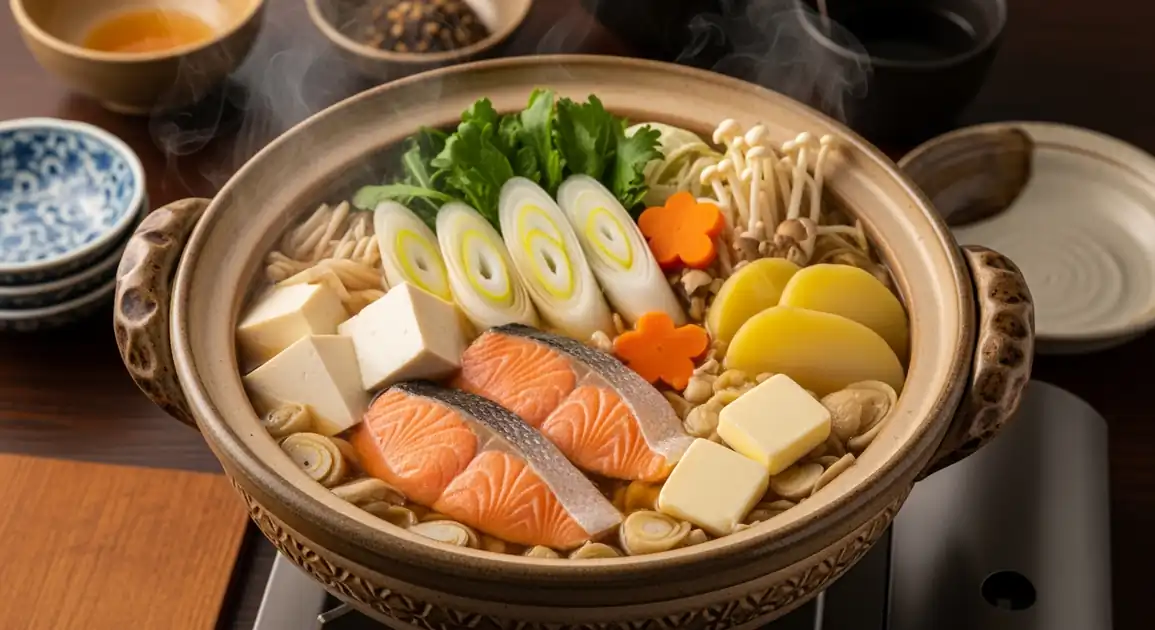Ishikari Nabe (Salmon Hot Pot)
石狩鍋

Description
Ishikari Nabe is found throughout Japan, particularly during winter months, but its spiritual home is Hokkaido where it originated. Outside of Hokkaido, it's often featured in izakayas and specialty restaurants as a representative dish of northern Japanese cuisine, though traditional preparations are most authentic in Hokkaido itself.
Dietary Information
Serving information
Serving style
Served in a communal earthenware pot (donabe) placed on a portable burner at the table, allowing ingredients to cook during the meal. Each diner receives an individual bowl for their portion.
Quick facts
Lunch service typically 11 AM - 2 PM, dinner service 5 PM - 10 PM. Many specialty restaurants closed between lunch and dinner services.
Safety Tips
What to Look For
-
Fresh, bright pink salmon with firm texture
The salmon should have vibrant color without brown spots or dull appearance. It should maintain its shape rather than breaking apart too easily, indicating it hasn't been frozen/thawed multiple times.
-
Clean, mild fishy aroma from the broth
A pleasant, subtle fish aroma indicates fresh ingredients. Strong fishy smells suggest lower quality or older fish.
-
Restaurants specializing in Hokkaido cuisine
Establishments that focus on Hokkaido regional food are more likely to use authentic recipes and source quality salmon.
-
Proper cooking temperature (gentle simmer)
The broth should be maintained at a gentle bubbling simmer, not a rolling boil which would overcook the salmon or a too-low temperature which might not cook ingredients thoroughly.
-
Seasonal availability emphasis
Good restaurants may only serve Ishikari Nabe during colder months when ingredients are at their peak quality and the dish is most appropriate.
What to avoid
-
Pre-cooked salmon added to the broth
Authentic preparation cooks the raw salmon directly in the hot pot. Pre-cooked salmon loses flavor and can indicate poor quality control.
-
Very fishy or ammonia-like smell
These odors indicate old or deteriorating fish, which could pose health risks.
-
Artificially bright red/orange salmon
Unnaturally vivid coloring may indicate artificial dyes used to mask lower quality fish.
-
Recycled broth
Some budget places might reuse broth from previous servings. Fresh broth should be prepared for each order.
-
Inconsistent ingredients across multiple visits
Quality restaurants maintain consistent standards for their signature dishes. Major variations in recipe or portion sizes may indicate corner-cutting.
Price information
Price range
Budget tips
- Lunch specials often offer better value (1500-2500 JPY) than dinner service.
- Many restaurants offer multi-person serving sizes that provide better value per person.
- Izakayas typically offer more affordable versions (around 1800-2500 JPY) than specialty restaurants.
- Winter seasonal promotions may feature discounted rates when ingredients are most abundant.
Value indicators
- Generous salmon portions rather than mostly vegetables.
- Use of visible Hokkaido-sourced ingredients.
- Handmade broth rather than from commercial miso soup base.
- Customization options for broth strength or ingredients.
- Option to add ingredients like udon noodles at the end of the meal.
Where to Find This Dish
Restaurant Districts
Found in areas with concentrations of traditional Japanese restaurants.
Izakaya streets, Traditional restaurant zones
Dinner (5 PM - 9 PM)
Hokkaido-themed Restaurants
Restaurants specializing in northern Japanese cuisine.
Restaurants with Hokkaido in the name, Seafood specialty restaurants
Lunch (11 AM - 2 PM), Dinner (5 PM - 9 PM)
Department Store Restaurant Floors
Upper floors of major department stores often include restaurants serving regional specialties.
Department store dining floors
Lunch (11 AM - 2 PM)
Vendor Tips
- Restaurants displaying the actual hot pot or photos of it prominently usually specialize in the dish.
- Ask if they use Hokkaido-sourced salmon for the most authentic experience.
- Confirm if the dish is prepared for individual servings or requires a minimum number of diners.
How to Order
Regional Variations
-
Traditional Ishikari Nabe
(伝統的な石狩鍋)
The classic version with salmon, vegetables, tofu, and miso broth. Often includes a small pat of butter in Hokkaido.
-
Ishikari Nabe with Milk/Cream
(ミルク/クリーム入り石狩鍋)
A richer variation where milk or cream is added to the broth, creating a creamier texture popular in modern interpretations.
-
Salmon Head Ishikari Nabe
(鮭頭石狩鍋)
Traditional variation using salmon head rather than fillets, prized for its rich flavor and considered more authentic by purists.
-
Seafood Ishikari Nabe
(海鮮石狩鍋)
Expanded version that includes additional seafood like scallops, crab, or prawns alongside the essential salmon.
-
Butter-Enriched Ishikari Nabe
(バターたっぷり石狩鍋)
Version emphasizing Hokkaido's famous dairy by using generous amounts of local butter, creating a richer, more indulgent broth.
-
Vegetable-Forward Ishikari Nabe
(野菜たっぷり石狩鍋)
Includes a wider variety of vegetables, sometimes including Hokkaido specialties like corn and pumpkin alongside the traditional ingredients.
Cultural context
History
Ishikari Nabe originated among fishermen along Hokkaido's Ishikari River, one of Japan's premier salmon habitats. Dating back to the late 19th century, it began as a simple fisherman's meal using fresh-caught salmon cooked outdoors in portable pots. The dish evolved as Hokkaido's dairy industry developed, incorporating butter—a distinctive regional ingredient rare in traditional Japanese cuisine. Now considered Hokkaido's representative hot pot dish, it embodies the region's natural abundance and cultural history.
Local significance
Ishikari Nabe represents Hokkaido's fishing heritage, particularly salmon from the Ishikari River. It symbolizes the importance of communal dining in Japanese culture, especially during winter months.
Eating customs
- Eaten directly from the communal pot using personal chopsticks or served in individual bowls.
- It's polite to take a balanced portion of both broth and solid ingredients.
- Adding rice to the remaining broth at the end of the meal is common practice.
- In some restaurants, staff will help manage the cooking process, adding ingredients at the optimal time.